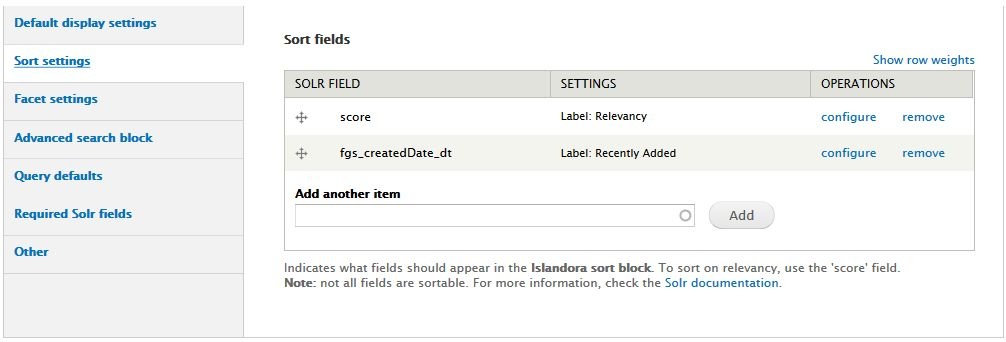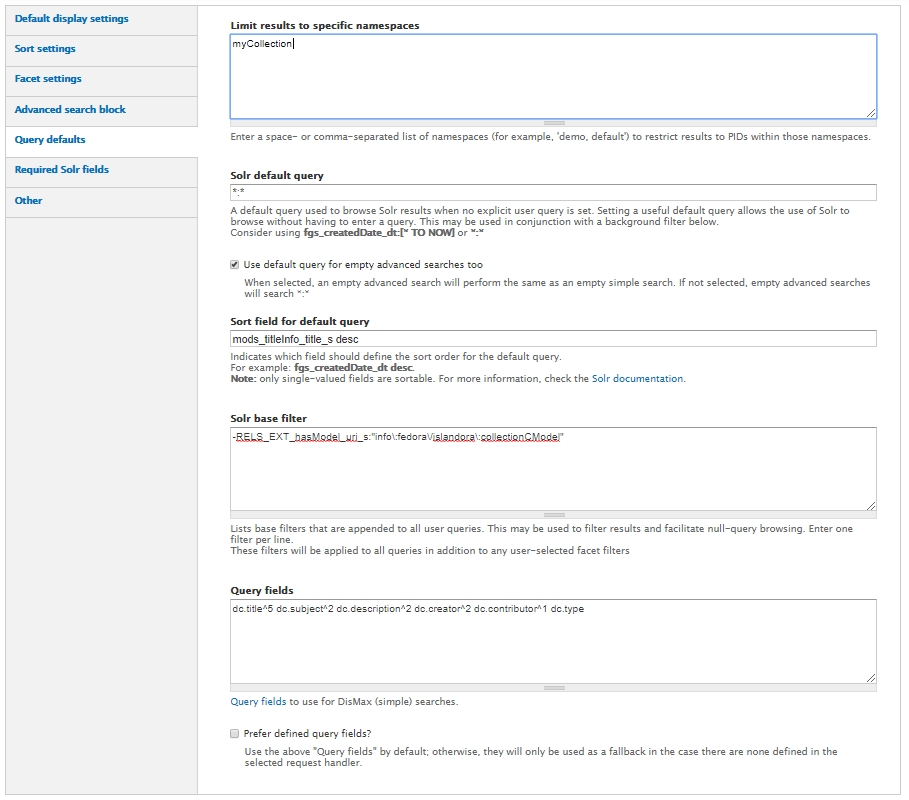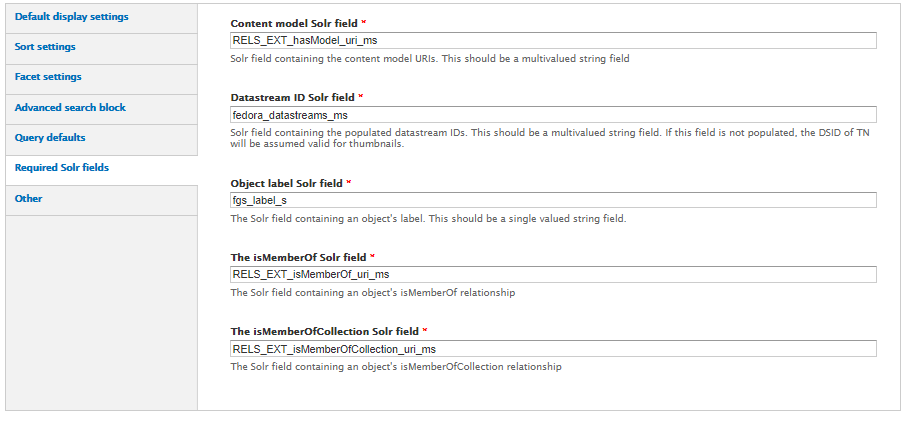...
The Islandora Solr Settings page has configuration options for searching and displaying Islandora object properties, descriptive metadata, full text, and OCR data of stored in Solr.
Configuration
Display Profiles
This menu control controls how search results are displayed.
...
- Bookmark - This is used by the Islandora Bookmark module, which must be enabled and configured separately, to display search results as a table in which a checkbox appears next to each item for the purpose of bookmarking it.
- List - This is the default Islandora display profile. This displays all fields available unless check unless you check "Limit results to fields listed above?" and specify in the Default display settings which fields you want displayed.
- Grid - This displays the thumbnail and title field of every item in the results (similar to how collections are displayed by default).
- Table - This displays results as a table, with a column for each Solr field configured in the Default display settings menu. This profile can be configured under the Table Profile Settings tab.
...
Secondary display profiles
- CSV - This enables an the option to export the search results of a Solr search as a comma-separated file.
- RSS - This enables an the option to make search results of a Solr search available as an RSS feed. This profile is configured in the RSS Settings tab.
Enabling these These options will place an icon for the respective option next to your Solr search results.
Default display settings
This section has provides options to set for setting which Solr fields display and how they are to be displayed in search results for the "List" and "Table" display profiles. The "Grid" and "Bookmark" profiles are not affected by these settings.
...
- In the "Add another item" box, begin typing a Solr field name (the box will provide suggestions as you type). See Appendix D for a list of eligible field names.
- Click Add to add the field to the display.
- Once a field has been added, click Configure for more options. Different Solr field types will have different options for configuration.
- Label: Enter a user-friendly display label to represent the field in the search results.
- Linking: Link this field to the object it describes (use for fairly unique values, like titles or identifiers). With some fields it can be used as a link to perform a new Solr search based on the value of the field (such as author names, subject terms, or series titles for a related items search).
- Highlight: Check this box to enable highlighting the search term in the field(s) where it is found (keyword in context). Only works on tokenized Solr fields. See Appendix D where this is explained.
- Maximum length: Truncate field values in the search results display. Useful Especially useful for longer potentially long fields such as notes, descriptions, or and full text fields.
- Permissions: Specify user roles that should have access to this field.
...
Check this box to limit the search results fields displayed to display only the Solr fields entered only those specified in Display fields. This setting will affect the "List" and "Table" display only. The "Grid" display is fixed. To configure the metadata for the "Bookmark" display see Islandora Bookmark.
...
You can expose this function to users by adding the Islandora search navigation block to a region (such as the First Sidebar or Second Sidebar) in admin/structure/block.
...
The fields must not be multivalued fields in Solr. For more on this see Appendix D.
You can expose the sort fields to users by adding the Islandora sort block to a region (such as a sidebar) in admin/structure/block.
The default sort field is "score" which is a relevancy ranking based on how well the search query matches each result. The way that different fields are valued is configurable in Solr.
You can expose the sort fields to users by adding the Islandora sort block to a region (such as a sidebar) in admin/structure/block.

Facet settings
This is where you can specify terms that users can choose to help narrow down a result set to only those items that match that term, such as a specific subject heading, or were created by a specific author, or are of a certain type, or are within a certain date range.
Facet fields mut must be non-tokenized strings in Solr. For more on this see Appendix D. As you type in the fields in "Add another item" the eligible Solr fields will be indicated with the word "(string)."
you You can expose the facet to users by adding the Islandora facets block to a region (such as a sidebar) in admin/structure/block.
...
The values appearing in the figure below serve only as examples.
 Image Removed
Image Removed Image Added
Image Added
Required Solr fields
These Solr fields are required by Islandora in order to create a repository browse interface and manage Fedora objects. These fields are populated with default values This menu specifies which fields Solr uses to create the default repository browse result set and should probably not be changed.

Other (debugging Solr)
This section contains a checkbox to turn "debug mode" on or off. Debug mode for Solr will show the If checked the "Debug mode" will display the raw text of Solr queries in the Drupal display, and generally should not be used in Islandora's Drupal interface. It should be unchecked when used on a production site.

Note:
Many of the options configured in the Solr Settings menus affect only searches and results sets associated with Solr searches. You can recognize a Solr search by the URL string "/islandora/search/...". Other types of searches, such as browsing using URLs like "/islandora/repository/" and some like "/islandora/object/..." will are not be affected by some of the all options set here in Solr Settings.
...

